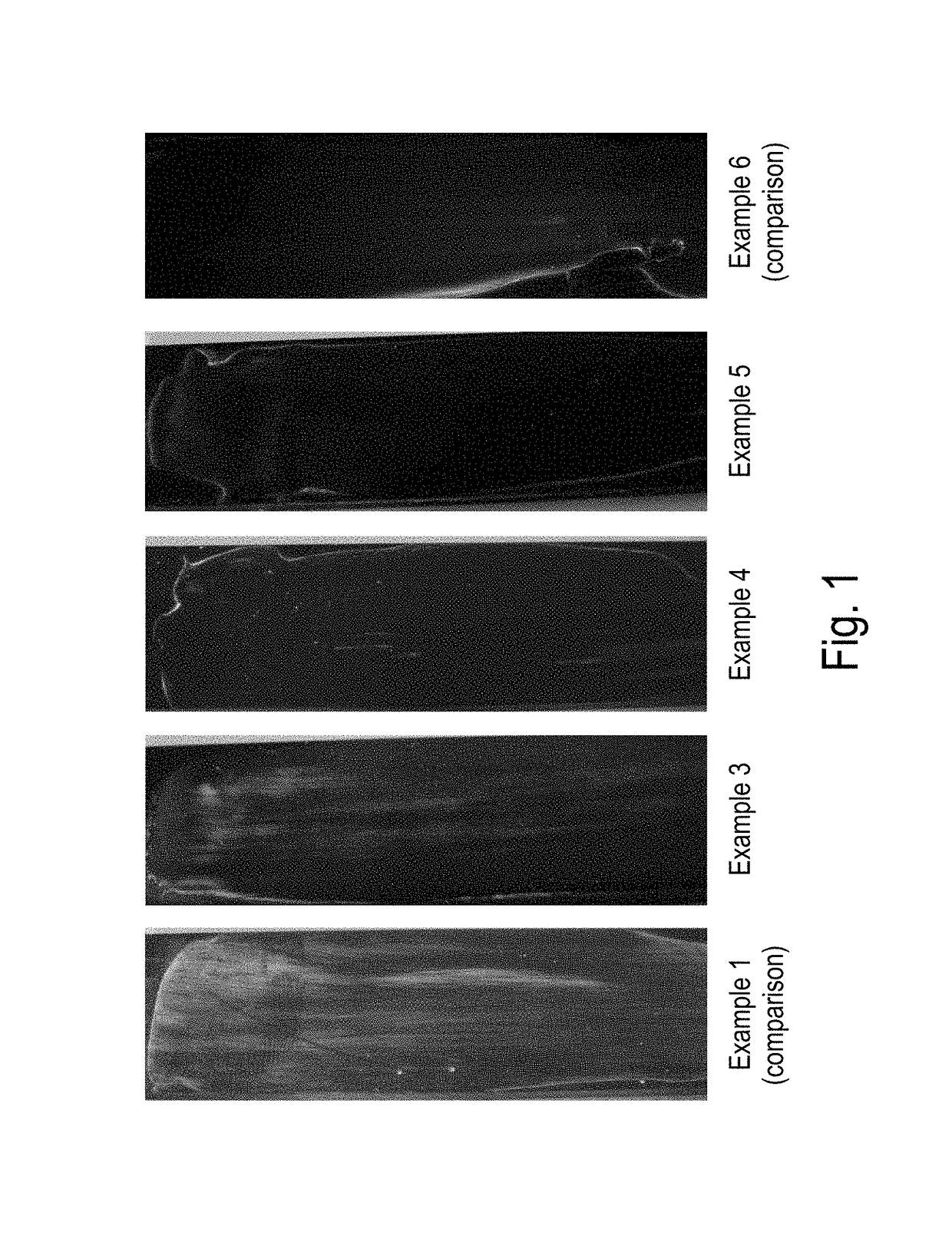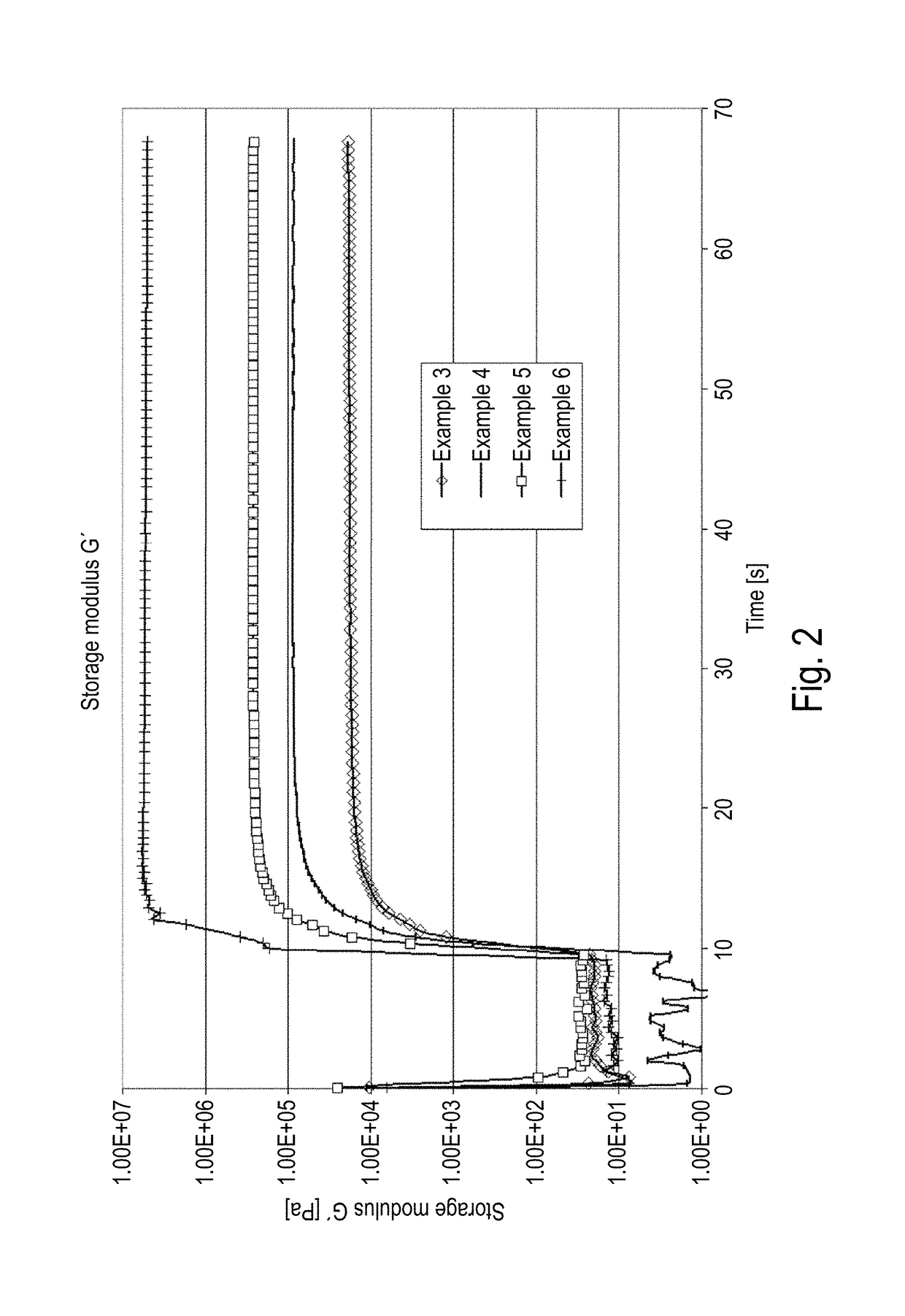Dual-curing solvent-free single-component masses and their use
a technology of solvent-free single components and polymer components, applied in the direction of adhesive types, polyurea/polyurethane coatings, coatings, etc., can solve the problems of high technical effort, inability to inhibit oxygen, and surface moisture, and achieve the effect of suitable application
- Summary
- Abstract
- Description
- Claims
- Application Information
AI Technical Summary
Benefits of technology
Problems solved by technology
Method used
Image
Examples
example 3
[0108]The following components were mixed and homogenized to produce a dual-curing epoxy resin:
[0109]51.5% bisphenol-A epoxy resin (Araldite™ GY250 from Huntsman)
[0110]20.3% hybrid compound (Laromer™ LR9000 from BASF)
[0111]1.3% photoinitiator (CGI 403™ from BASF)
[0112]26.0% latent curing agent (EH-4360S™ from Adeka)
[0113]1.2% thixotropic agent (HDK H18™ from Wacker)
[0114]This example shows that the surface of the mass after light curing at a low storage modulus of approx. 25,000 Pa is substantially dry. Even if there remain some residues in the talcum test, the surface dryness of the mass can already be regarded as satisfactory for some applications. The mechanical properties of the mass (cohesion, elongation at break and compression shear strength) are similar to the properties of the known heat-curing epoxy resins according to Example 2 (see Table 1).
example 4
[0115]The following components were mixed and homogenized to produce a dual-curing epoxy resin according to the present invention:[0116]55.5% bisphenol-A / F epoxy resin (POLYPDX™ E237 from Dow Chemicals)[0117]5.0% hybrid compound (Laromer™ LR9000 from BASF)[0118]15.0% hybrid compound according to the below manufacturing specification[0119]1.5% photoinitiator (Irgacure™ 184 from BASF)[0120]22.0% latent curing agent (EH-4357S™ from Adeka)[0121]1.0% thixotropic agent (Cab-O-Sil™ M5 from Cabot)
[0122]To produce the hybrid compound used in this example, 0.05 g 2,6-di-tert-butyl-4-methylphenol and 0.05 g hydroquinone monomethyl ether were added to 110 g of an aliphatic polyisocyanate (Vestanat™ HB 2640 / LV from Evonik, NCI content: 23%) at room temperature while stirring. Thereafter, 29 g 4-hydroxybutyl acrylate was added in drops. After the addition was completed, 0.01 g dibutyltin dilaurate was added in drops while stirring and the temperature was increased to 45° C. for 3 hours. The degre...
example 5
[0126]The following components were mixed and homogenized to produce a dual-curing epoxy resin according to the present invention:
[0127]50.5% bisphenol-A epoxy resin (Araldite™ GY250 from Huntsman)
[0128]25.0% hybrid compound according to the manufacturing specification of Example 4
[0129]1.5% photoinitiator (Lucirin™ TPO from BASF)
[0130]22.0% latent curing agent (Ajicure™ PN-23 from Ajinomoto)
[0131]1.0% thixotropic agent (HDK H18™ from Wacker)
[0132]This example shows that the masses according to the present invention with a high storage modulus of approx. 0.3 MPa exhibit completely dry surfaces while being further cured by heat curing. The mechanical properties of the mass after heat curing (cohesion, elongation at break and compression shear strength) are comparable to the properties of the heat-cured epoxy resin according to Example 2 (see Table 1).
PUM
| Property | Measurement | Unit |
|---|---|---|
| storage modulus | aaaaa | aaaaa |
| storage modulus | aaaaa | aaaaa |
| wavelength | aaaaa | aaaaa |
Abstract
Description
Claims
Application Information
 Login to View More
Login to View More - R&D
- Intellectual Property
- Life Sciences
- Materials
- Tech Scout
- Unparalleled Data Quality
- Higher Quality Content
- 60% Fewer Hallucinations
Browse by: Latest US Patents, China's latest patents, Technical Efficacy Thesaurus, Application Domain, Technology Topic, Popular Technical Reports.
© 2025 PatSnap. All rights reserved.Legal|Privacy policy|Modern Slavery Act Transparency Statement|Sitemap|About US| Contact US: help@patsnap.com


